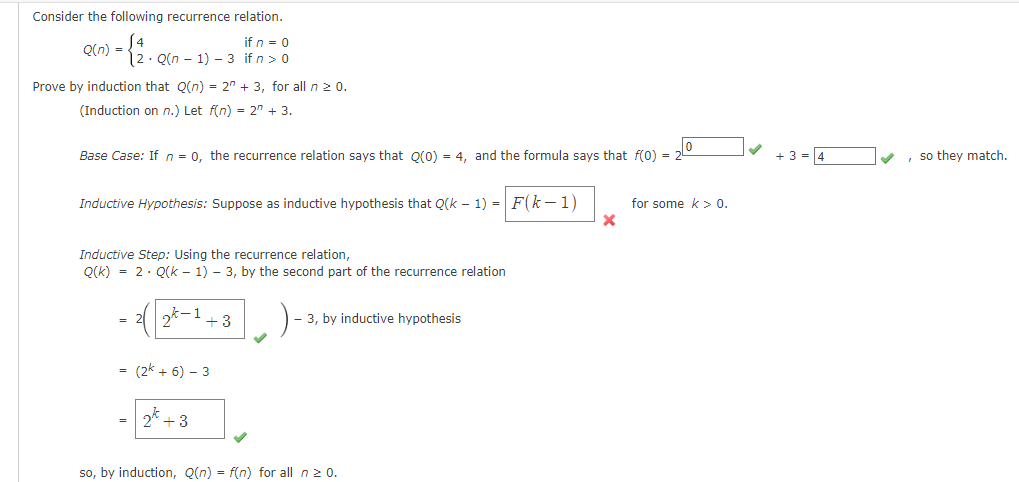Consider the following recurrence relation. if n = 0 if n > 0 Q(n) - {2. (2. Q(n-1)-3 Prove by induction that Q(n) = 2 (Induction on n.) Let f(n) = 2" + 3. Base Case: If n = 0, the recurrence relation says that Q(0) = 4, and the formula says that f(0) = + 3, for all n ≥ 0. Inductive Hypothesis: Suppose as inductive hypothesis that Q(k-1)= F(k-1) Inductive Step: Using the recurrence relation, Q(K) = 2 Q(k-1)-3, by the second part of the recurrence relation 2-1+3 = (2k + 6)-3 -2²+3 - 3, by inductive hypothesis so, by induction, Q(n) = f(n) for all n ≥ 0. X for some k> 0. , so they match.
Consider the following recurrence relation. if n = 0 if n > 0 Q(n) - {2. (2. Q(n-1)-3 Prove by induction that Q(n) = 2 (Induction on n.) Let f(n) = 2" + 3. Base Case: If n = 0, the recurrence relation says that Q(0) = 4, and the formula says that f(0) = + 3, for all n ≥ 0. Inductive Hypothesis: Suppose as inductive hypothesis that Q(k-1)= F(k-1) Inductive Step: Using the recurrence relation, Q(K) = 2 Q(k-1)-3, by the second part of the recurrence relation 2-1+3 = (2k + 6)-3 -2²+3 - 3, by inductive hypothesis so, by induction, Q(n) = f(n) for all n ≥ 0. X for some k> 0. , so they match.
Database System Concepts
7th Edition
ISBN:9780078022159
Author:Abraham Silberschatz Professor, Henry F. Korth, S. Sudarshan
Publisher:Abraham Silberschatz Professor, Henry F. Korth, S. Sudarshan
Chapter1: Introduction
Section: Chapter Questions
Problem 1PE
Related questions
Question
100%
need help with x mark box

Transcribed Image Text:Consider the following recurrence relation.
if n = 0
Q(n) = {2. Q(n-1) - 3 ifn > 0
Prove by induction that Q(n) = 2
(Induction on n.) Let f(n) = 2" + 3.
0
Base Case: If n = 0, the recurrence relation says that Q(0) = 4, and the formula says that f(0) =
Inductive Hypothesis: Suppose as inductive hypothesis that Q(k-1)= F(k-1)
+ 3, for all n ≥ 0.
Inductive Step: Using the recurrence relation,
Q(K) = 2.Q(k-1)-3, by the second part of the recurrence relation
=
₂k-1
+3
= (2k + 6) - 3
2² +3
- 3, by inductive hypothesis
so, by induction, Q(n) = f(n) for all n ≥ 0.
X
for some k > 0.
+ 3 = 4
s
, so they match.
Expert Solution
This question has been solved!
Explore an expertly crafted, step-by-step solution for a thorough understanding of key concepts.
This is a popular solution!
Trending now
This is a popular solution!
Step by step
Solved in 2 steps

Knowledge Booster
Learn more about
Need a deep-dive on the concept behind this application? Look no further. Learn more about this topic, computer-science and related others by exploring similar questions and additional content below.Recommended textbooks for you

Database System Concepts
Computer Science
ISBN:
9780078022159
Author:
Abraham Silberschatz Professor, Henry F. Korth, S. Sudarshan
Publisher:
McGraw-Hill Education

Starting Out with Python (4th Edition)
Computer Science
ISBN:
9780134444321
Author:
Tony Gaddis
Publisher:
PEARSON

Digital Fundamentals (11th Edition)
Computer Science
ISBN:
9780132737968
Author:
Thomas L. Floyd
Publisher:
PEARSON

Database System Concepts
Computer Science
ISBN:
9780078022159
Author:
Abraham Silberschatz Professor, Henry F. Korth, S. Sudarshan
Publisher:
McGraw-Hill Education

Starting Out with Python (4th Edition)
Computer Science
ISBN:
9780134444321
Author:
Tony Gaddis
Publisher:
PEARSON

Digital Fundamentals (11th Edition)
Computer Science
ISBN:
9780132737968
Author:
Thomas L. Floyd
Publisher:
PEARSON

C How to Program (8th Edition)
Computer Science
ISBN:
9780133976892
Author:
Paul J. Deitel, Harvey Deitel
Publisher:
PEARSON

Database Systems: Design, Implementation, & Manag…
Computer Science
ISBN:
9781337627900
Author:
Carlos Coronel, Steven Morris
Publisher:
Cengage Learning

Programmable Logic Controllers
Computer Science
ISBN:
9780073373843
Author:
Frank D. Petruzella
Publisher:
McGraw-Hill Education